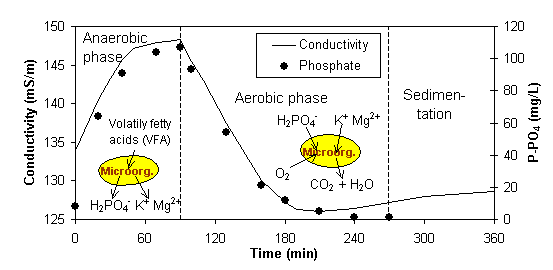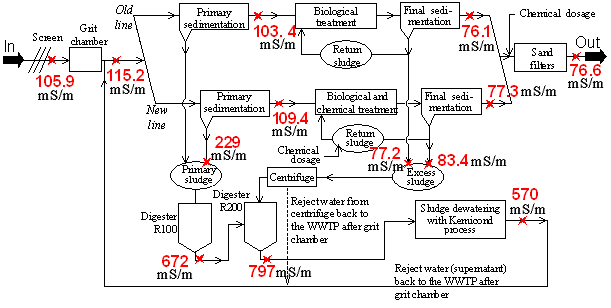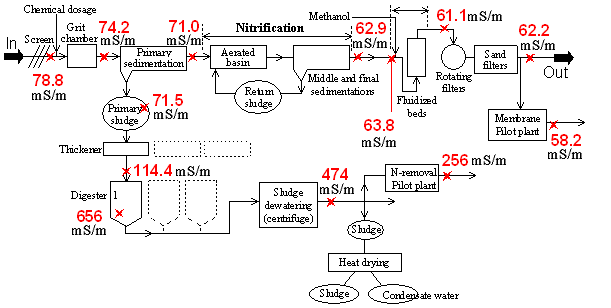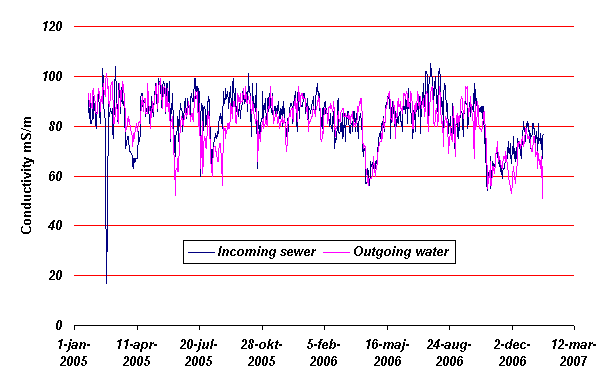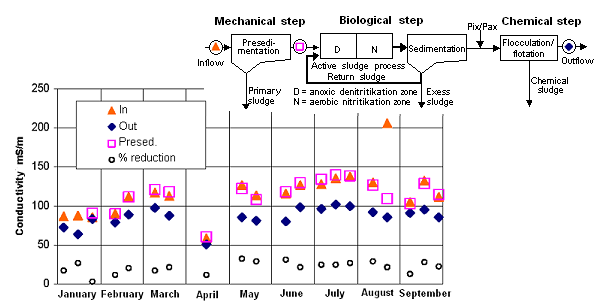KTH / Research projects at Water
Engineering and Resource management Research Group /
På
svenska
Conductivity measurements as measure and control methode for municipal wastewater treatmentParticipating persons:
|
||||||||||||||||||||||||||||||||||||||||||||||||||||||||||||||||

PUT YOUR WWTP CONTRIBUTE WITH CONDUCTIVITY VALUES TO THE PROJECT Project |
||||||||||||||||||||||||||||||||||||||||||||||||||||||||||||||||
Conductivity values have been measured at different locations in the process at two WWTP (Waste Water Treatment Plant) in the Stockholm region; Käppalaverket, Lidingö and Himmerfjärdsverket, Botkyrka. At Duvbacken WWTP in Gävle conductivity have been measured in inflow and outflow January 23, 2005 to January 22, 2007 and at Lotsbroverket WWTP in Mariehamn conductivity have been measured at inlet, outlet and after presedimantation January to September 2006. Käppala WWTP, Lidingö |
||||||||||||||||||||||||||||||||||||||||||||||||||||||||||||||||
| Käppala WWTP Lidingö | Himmerfjärden WWTP Botkyrka | Duvbacken WWTP Gävle | Lotsbroverket Mariehamn Åland |
||
| Old lines: | New lines: | ||||
| Capacity | 530 000 PE | 310 000 PE | 100 000 PE | 30 000 PE | |
| Process for P-removal |
Biological |
Chemical addition to return sludge | Chemical precipitation at presedimentation | Biological | Chemical flocculation and flotation in outflow |
| N-removal: Nitrification | Activated sludge process | Activated sludge process | None | Activated sludge process | |
| N-removal: Denitrification | Fluidized bed after sedimentation | ||||
| Inflow | 105.9 mS/m | 78.8 mS/m | 82.9 mS/m (mean) | 111 mS/m mean) | |
| Presedimentation |
103.4 mS/m | 109.4 mS/m | 71.0 mS/m | 115 mS/m (mean) | |
| After Act. Sludge | 76.1 mS/m | 77.3 mS/m | 63.8 mS/m | ||
| After denitrificat. | 61.1 mS/m | ||||
| Outlet | 76.6 mS/m | 62.2 mS/m | 81.6 mS/m (mean) | 86 mS/m (mean) | |
| % reduction | 28 % | 21 % | 1.6 % | 23 % | |
The three WWTP with biological nitrogen reduction Käppala, Himmerfjärdsverket and Lotsbroverket showed a decrease in conductivity in the process with 21 - 28 %, while Duvbacken WWTP which don´t have biological nitrogen reduction showed no decrease in conductivity. The contribution of phosphate ions to conductivity is based on calculations of analyses of sewage at Hammarby Sjöstad about 1 %. With uptake of counter ions biological phosphorus removal can reduce conductivity with about 3 %. Ammonia nitrogen and alkalinity which is reduced at biological nitrogen removal contributes to conductivity with 33 % and 14 % respectively. The conclusion is therefore that it is mainly biological nitrogen reduction which gives decrease in conductivity in the waste water treatment process.
Presentation
Levlin E. (2009) Conductivity measurements for controlling municipal wastewater treatment, International scientific seminar, Research and application of new technologies in wastewater treatment and municipal solid waste disposal in Ukraine, Sweden and Poland October, Ustron, Poland, November 23-24, 2007 paper.
The project has been completed with Svensk Vatten Utveckling
rapport Nr 2008-04.
The report (in swedish) can be obtained at: http://vav.griffel.net/filer/Rapport_2008-04.pdf
Page created by Erik Levlin
